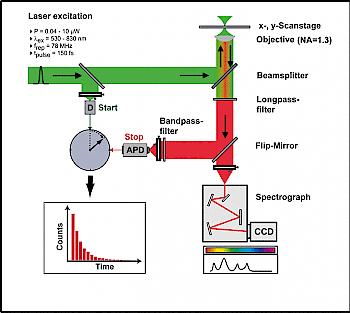Time-resolved microscopy
We utilize two techniques for time-resolved confocal microscopy and spectroscopy: 1. Time-resolved photoluminescene detection based on time-correlated single photon counting (TCSPC) and 2. a pump-probe approach in which transient changes in the intensity of the reflected / scattered light are detected. We have several TCSPC-microscope setups equipped with various laser sources. One setup is connected to a low-temperature cryostat (5-300 K), another can also be run as transient scattering microscope.
1. Time-correlated single photon counting
We apply TCSPC microscopy with a temporal resolution of ~5 ps and a spatial resolution of ~300 nm to various material systems such as single-walled carbon nanotubes and perovskites, Optical excitation of single-walled carbon nanotubes generates excitons. Exciton decay dynamics are of major importance both for our understanding of the fundamental physics and for all light-based device applications of these 1D quantum systems. To avoid the major disadvantages of ensemble measurements, namely overlapping contributions from different tube species and averaging over tubes of the same species but with different individual properties (e.g. defect concentration), single nanotube experiments are required.
Setup for time-resolved photoluminescence spectroscopy
2. Transient scattering microscopy
In transient scattering microsopy, changes in the scattering signal of the sample induced by a prior pump-pulse are detected. Varying the time-delay between pump and probe pulse allows to investigate the excited state dynamics of the sample.
